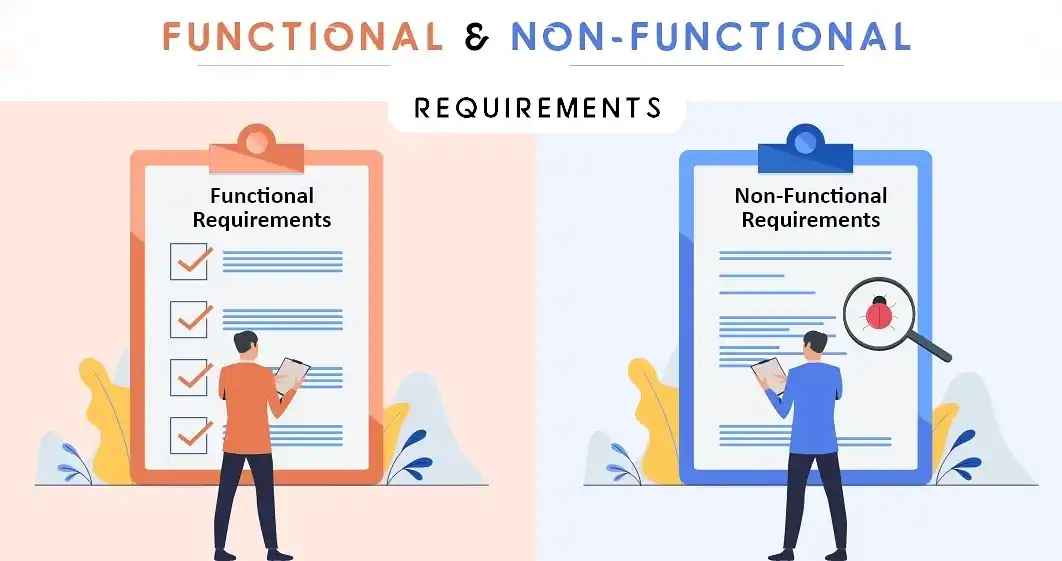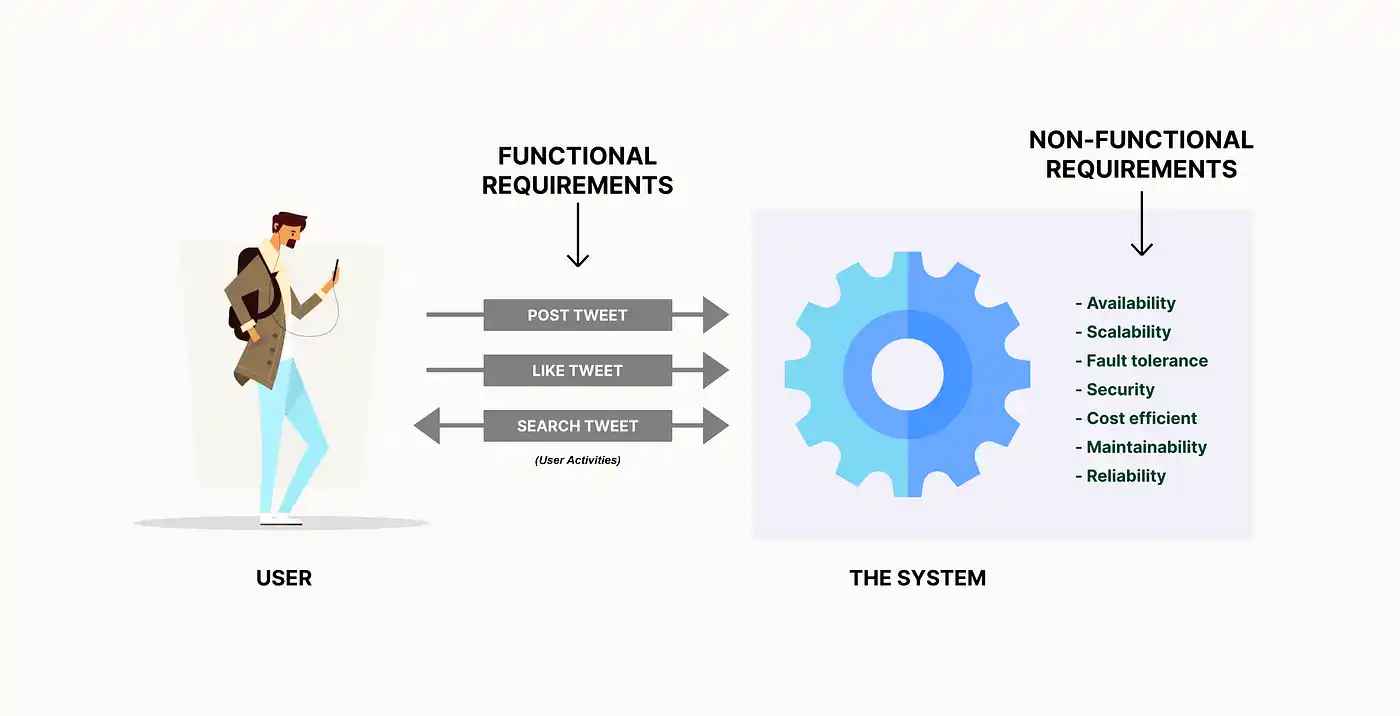Functional vs Non-Functional Requirements in Software Engineering
Updated on : 9 May 2025

Image Source: google.com
Table Of Contents
- 1. Introduction
- 2. Understanding Functional Requirements in Software Projects
- 3. Exploring Non-Functional Requirements and Their Role
- 4. An Overview of Extended Software Requirements
- 5. Key Examples of Functional vs Non-Functional Requirements
- 6. Functional vs Non-Functional: What Sets Them Apart
- 7. Why Balancing Both Types of Requirements Is Crucial
- 8. Challenges in Identifying Software System Requirements
- 9. Effective Techniques for Collecting All Requirement Types
- 10. Impact of Functional Requirements on System Behavior
- 11. How Non-Functional Traits Influence User Experience
- 12. Tools and Methods for Documenting Requirements Clearly
- 13. Real-World Case Studies on Requirement Specifications
- 14. FAQs
Table Of Contents
Introduction
In the world of tech, knowing functional vs non-functional requirements in software engineering is like knowing the rules of the game. Functional tells what the system must do non-functional reveals how well it does it. Together, they shape smarter, user-focused software.
Understanding Functional Requirements in Software Projects

Image Source: google
| 🔄 Stage | 📌 Description |
|---|---|
| Requirement Elicitation | The process of gathering functional requirements from stakeholders to understand the needs of the system. |
| Requirement Analysis | Analyzing and refining the gathered requirements to ensure they are clear, complete, and feasible. |
| Requirement Specification | Documenting the functional requirements in a detailed and structured format for development. |
| Requirement Validation | Ensuring that the documented requirements align with the stakeholders' expectations and business goals. |
| Requirement Prioritization | Determining the most critical functional requirements to address first, based on stakeholder input. |
| Design | Translating the functional requirements into system and software designs. |
| Implementation | Building the software system according to the functional requirements specified. |
| Testing | Verifying that the software meets the functional requirements and works as expected. |
| Deployment | Releasing the software with all the functional features fully implemented and tested. |
| Maintenance | Ongoing support and enhancement of the software based on feedback and changing requirements. |
Exploring Non-Functional Requirements and Their Role
Non-functional requirements (NFRs) define how a system performs rather than what it does. They focus on qualities such as performance, security, and usability, ensuring a system runs smoothly and meets user expectations.
-
Definition: NFRs describe the system's operational qualities, unlike functional requirements which define specific system behaviors. 🛠️
-
Key Categories:
-
Performance: Speed and efficiency 🚀
-
Scalability: Ability to handle growth ��📈
-
Security: Data protection 🔒
-
Usability: Ease of use 🧑💻
-
Reliability: Consistent performance 🔄
-
Functional vs Non-Functional Requirements in Software Engineering: Both types of requirements are essential. Functional requirements define what the system does, while non-functional requirements define how well it does it. ⚙️ vs 🔧
Non-functional requirements are just as crucial as functional ones for creating efficient, reliable, and user-friendly systems.
Explore Software Development services in Hexadecimal Software
An Overview of Extended Software Requirements
| 🔄 Requirement | 📌 Description |
|---|---|
| Functional Requirements | Describe what the software should do. |
| Non-Functional Requirements | Describe how the software should perform. |
| User Requirements | Define what users need from the software. |
| System Requirements | Detail the hardware and software needed to run the software. |
| Interface Requirements | Describe how the software interacts with other systems. |
| Performance Requirements | Define the speed and efficiency of the software. |
| Security Requirements | Define how the software keeps data safe. |
| Compliance Requirements | Ensure the software follows legal and industry standards. |
| Usability Requirements | Describe how easy and user-friendly the software is. |
| Maintainability Requirements | Describe how easy it is to update and fix the software. |

Need help navigating the SDLC for your project?
Key Examples of Functional vs Non-Functional Requirements

Image Source: google
| 🔄 Aspect | 📌 Functional Requirements | 📌 Non-Functional Requirements |
|---|---|---|
| Definition | Describe *what* the system should do. | Describe *how* the system should perform. |
| Focus | System behaviors and actions. | System qualities and performance standards. |
| Example | User login, data entry, etc. | Performance speed, security, availability. |
| Measurement | Can be measured by specific functionalities. | Measured by attributes like speed, security, etc. |
| Impact | Directly affects system functionality. | Impacts the overall system experience and quality. |
| Change Frequency | May change with new features or updates. | Usually stable, changes only for performance upgrades. |
Functional vs Non-Functional: What Sets Them Apart
Functional vs Non-Functional Requirements in Software Engineering refer to two distinct types of system needs, both essential for a successful software project. Understanding their differences helps in clearly defining what a system should do and how it should perform.
Functional Requirements:
- Define what the system should do (e.g., user login, data processing).
- Directly describe specific behaviors and actions of the system.
- Example: "The system must allow users to submit feedback."
Non-Functional Requirements:
-
Define how the system should perform (e.g., performance, security).
-
Focus on system qualities and overall user experience.
-
Example: "The system should respond to user requests within 2 seconds."
-
Functional vs Non-Functional Requirements in Software Engineering:
-
Functional requirements address specific actions of the software, while non-functional requirements focus on the overall performance and user satisfaction.
Both types of requirements are crucial for ensuring that a system works as intended and provides a good user experience.
Why Balancing Both Types of Requirements Is Crucial
| 🔄 Aspect | 📌 Functional Requirements | 📌 Non-Functional Requirements |
|---|---|---|
| Purpose | Define the core functionality of the system. | Define the quality and performance standards of the system. |
| Impact | Directly affects system behavior. | Affects system reliability, user satisfaction, and scalability. |
| Example | User can register and log in. | System responds in under 3 seconds and is secure. |
| Dependency | Relies on specific actions and features. | Relies on performance, security, and usability metrics. |
| Balance Importance | Without functional requirements, the system wouldn’t work as intended. | Without non-functional requirements, the system may perform poorly or be insecure. |
You Might Also Like
Challenges in Identifying Software System Requirements

Image Source: google
| 🔄 Challenge | 📌 Description |
|---|---|
| Unclear Stakeholder Communication | Stakeholders may struggle to express their needs clearly, leading to misunderstandings. |
| Changing Requirements | Requirements may change over time as business needs evolve, causing scope creep. |
| Ambiguous Requirements | Vague or incomplete requirements make it difficult to design and develop a system. |
| Conflicting Requirements | Different stakeholders may have conflicting or contradictory requirements. |
| Lack of Prioritization | Not prioritizing requirements can lead to confusion about which features are most important. |
| Technical Constraints | Existing technology or infrastructure may limit what can be achieved in the software. |
| Resource Limitations | Limited budget, time, or personnel may impact the ability to fully address all requirements. |
Effective Techniques for Collecting All Requirement Types
Collecting both Functional vs Non-Functional Requirements in Software Engineering is essential for developing a successful software system. Using a variety of techniques ensures that both types of requirements are gathered accurately and completely.
Interviews:
- Direct conversations with stakeholders to understand their needs.
- Helps identify both functional and non-functional requirements.
Surveys/Questionnaires:
- Distribute surveys to gather input from a larger group of users.
- Useful for collecting non-functional requirements like performance and usability.
Use Cases & User Stories:
- Describe specific system behaviors and scenarios.
- Focus on functional requirements but can also address non-functional aspects like reliability.
Prototyping:
- Build a working model of the system for user feedback.
- Helps clarify both functional vs non-functional requirements in software engineering, as users interact with the prototype.
Workshops:
- Collaborative sessions with stakeholders to define and prioritize requirements.
- Ensures that all types of requirements, both functional and non-functional, are identified and agreed upon.
Document Analysis:
- Review existing documentation (e.g., system specs, user manuals).
- Helps identify non-functional requirements like security and compliance.
By using these techniques, you can ensure a comprehensive understanding of both functional vs non-functional requirements in software engineering, leading to a well-rounded and effective system design.

Looking to integrate advanced solutions for your software development?
Impact of Functional Requirements on System Behavior
| 🔄 Aspect | 📌 Impact of Functional Requirements on System Behavior |
|---|---|
| System Actions | Define specific actions the system must perform (e.g., user login, data processing). |
| User Interaction | Guide how users interact with the system (e.g., buttons, forms). |
| System Outputs | Determine the expected results from system operations (e.g., reports, notifications). |
| Process Flow | Define the flow of tasks and activities within the system (e.g., order processing, checkout). |
| System Interfaces | Outline how the system interacts with other systems or components (e.g., APIs, databases). |
| Error Handling | Define how the system responds to errors or failures (e.g., error messages, retries). |
How Non-Functional Traits Influence User Experience

Image Source: google
Non-functional traits directly impact how users feel while using a system. These qualities ensure the software is fast, secure, and easy to use, making it just as important as functional features.
- Performance 🚀
- Fast response times and smooth operation improve user satisfaction.
- A key part of Functional vs Non-Functional Requirements in Software Engineering.
- Usability 🧑💻
- Easy navigation and intuitive design make the system more user-friendly.
- Enhances the overall experience without changing core functions.
- Reliability 🔄
- Users trust the system more if it works consistently without crashing.
- Security 🔒
- Protects user data, builds trust, and encourages continued use.
- Availability ⏰
- High uptime ensures users can access the system when needed.
- Scalability 📈
- Supports growth without affecting performance, keeping experience smooth.
These traits show that Functional vs Non-Functional Requirements in Software Engineering must be balanced to create systems that are not only functional but also enjoyable and reliable for users.
Tools and Methods for Documenting Requirements Clearly
| 🔧 Tool/Method | 📌 Description |
|---|---|
| Use Case Diagrams | Visualize user interactions with the system to capture functional requirements clearly. |
| User Stories | Short, simple descriptions of a feature from the user's perspective. |
| Requirement Specifications (SRS) | Formal document listing all functional and non-functional requirements. |
| Wireframes/Mockups | Visual layouts showing interface design and flow for better understanding. |
| Flowcharts | Diagramming tool to represent processes or workflows in a system. |
| Spreadsheets | Simple tables to list, track, and organize requirements. |
| Requirements Management Tools | Tools like JIRA, Trello, or Azure DevOps used to capture and track requirements. |
| Prototypes | Clickable or interactive models to demonstrate system behavior before development. |
Real-World Case Studies on Requirement Specifications

Image Source: google
| 🏢 Project | 📌 Key Insight from Requirement Specification |
|---|---|
| E-Commerce Platform | Clear functional requirements helped define features like cart, checkout, and payment integration. |
| Banking App | Strong focus on non-functional requirements improved security and ensured regulatory compliance. |
| Healthcare System | Detailed user requirements ensured usability for doctors and nurses in a fast-paced environment. |
| Online Learning Portal | Well-documented requirements enabled smooth content delivery and high system availability. |
| Ride-Sharing App | Accurate system requirements supported real-time tracking and high performance under load. |
FAQs
Q.1. What are functional requirements?
A : They define what the system should do, like features and actions (e.g., login, search).
Q.2. What are non-functional requirements?
A : They describe how the system should perform, like speed, security, and usability.
Q.3. Why are both types important?
A : Functional requirements make the system work; non-functional make it work well.
Q.4. Can you give examples of each?
A : Functional: "User can reset password."
A : Non-Functional: "System loads in under 2 seconds."
Q.5. How are they documented?
A : Through user stories, use cases, diagrams, or requirement specification documents.
Q.6. Do non-functional requirements affect user experience?
A : Yes, they influence speed, reliability, and ease of use.
Q.7. Can one exist without the other?
A : Technically yes, but for a complete system, both are essential.
Q.8. How are they measured?
A : Functional: By testing if features work.
A : Non-Functional: By performance tests, security audits, etc.





